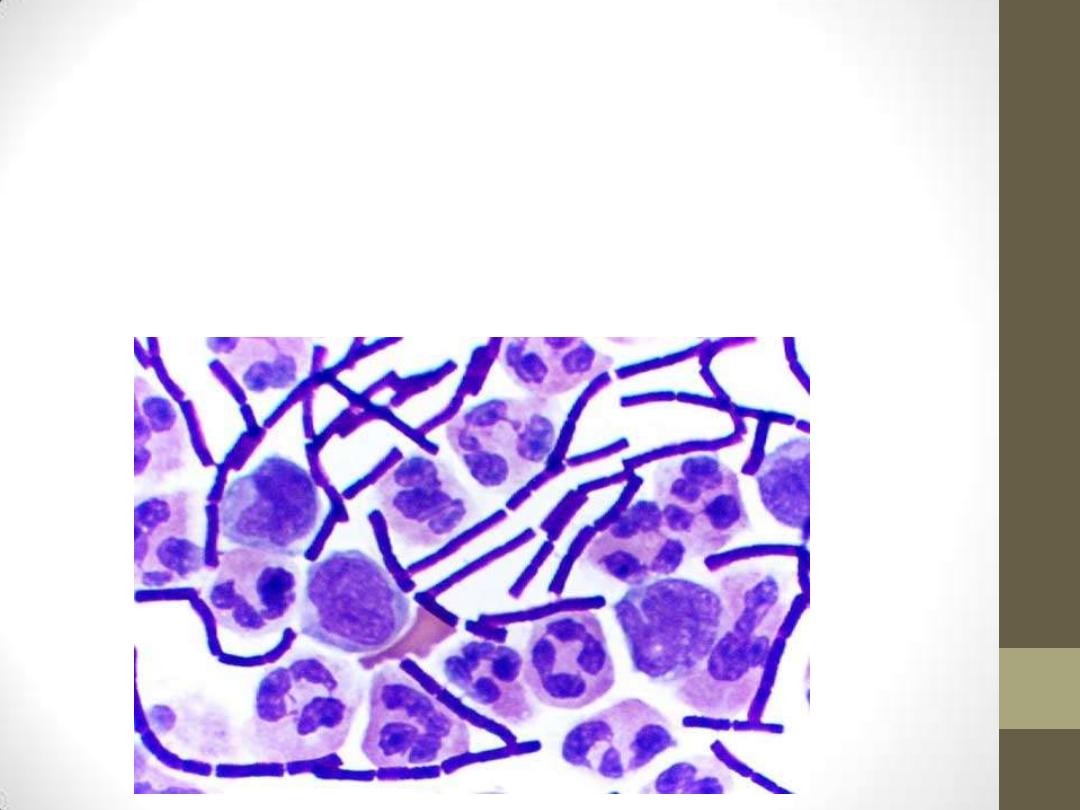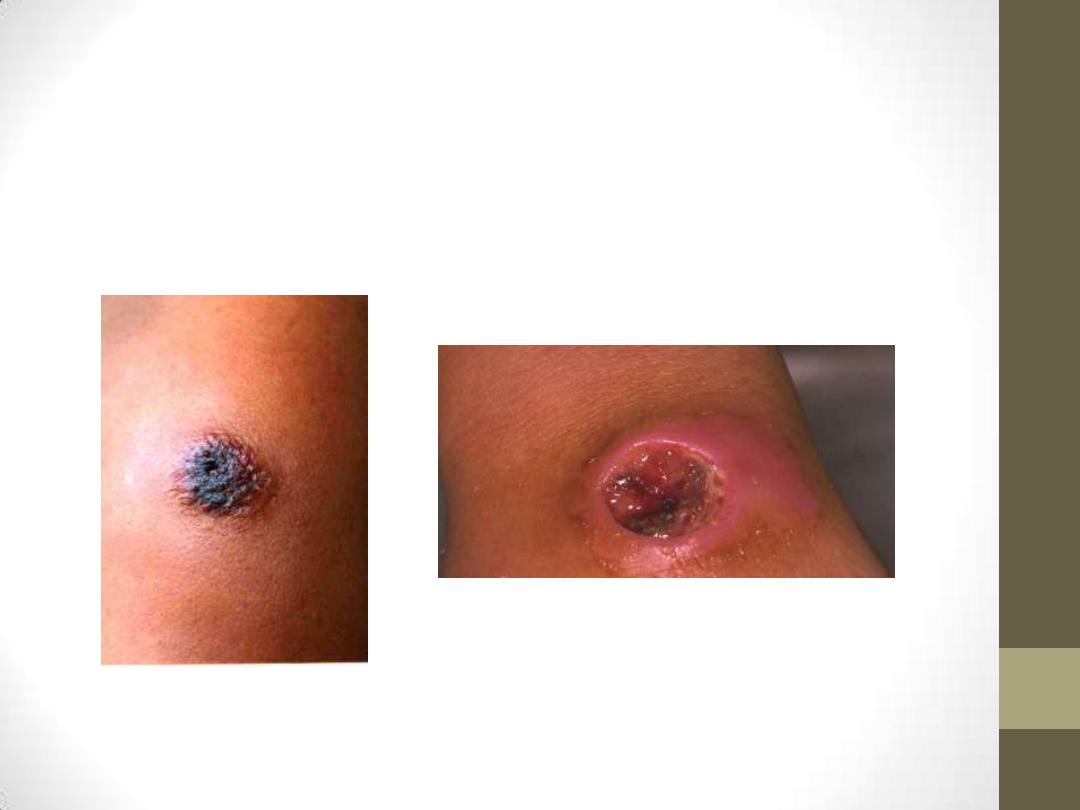
The family
Bacillaceae

The family Bacillaceae
The genera Bacillus and Clostridium constitute the family
Bacillaceae. Species are identified by using morphologic and
biochemical criteria.

Introduction
•
Bacillus species are aerobic, sporulating, rod-shaped bacteria
that are widely spread in nature. Bacillus anthracis, the agent
of anthrax, is the only obligate Bacillus pathogen in
vertebrates. A number of other species, in particular B cereus,
are occasional pathogens of humans and livestock, but the
large majority of Bacillus species are harmless saprophytes.
•
Bacillus species are used in many medical, pharmaceutical,
agricultural, and industrial processes that take advantage of
their wide range of physiologic characteristics and their ability
to produce a host of enzymes, antibiotics, and other
metabolites.

Introduction
•
Bacitracin and polymyxin are two well-known antibiotics
obtained from Bacillus species.
•
Several species are used as standards in medical and
pharmaceutical assays such as B stearothermophilus that are
used to test heat sterilization procedures, and B subtilis which
is resistant to heat, chemicals, and radiation, is widely used to
validate alternative sterilization and fumigation procedures.
•
Certain Bacillus species are important in the natural or
artificial degradation of waste products.

Introduction
Because the spores of many Bacillus species are resistant to
heat, radiation, disinfectants, and desiccation, they are difficult
to eliminate from medical and pharmaceutical materials and are
a frequent cause of contamination.

BACILLUS ANTHRACIS IS THE
CAUSATIVE AGENT
Anthrax

MORPHLOLGY
•
Larg gram-positive sporoforming non-motile rods
•
Sporeis usually oval and refractile.
•
Spore is central in position.

Culture
•
Aerobic culture conditions are suitable for growth of
B.anthracis.
•
Temperature range is 12-45C and it can grow on all ordinary
media such as blood agar and chocolate agar.
•
Morphology of the colony on culture media:
•
Typical colony have a wavy margin and small projections that
give medusa head appearance.


Pathogenesis
•
Anthrax is a disease of animal that transmissible secondarily
to human.
•
Human beings are relatively resistant to infection with
B.anthracis, but infection occurs when there is damage or
disturbance in local or systemic immunity.
•
Spores from infected animal or contaminated animal products
introduced in to the body by a skin abrasion ,inhalation and
ingestion are phagocyted by macrophage cells and
transported from the site of infection to the regional lymph
nods, where the spores germinate and vegetative bacteria
multiply. The bacilli then enter the blood stream causing
massive septicemia.

VIRULENCE FACTORS
The pathogenesis of B.anthracis depends primarly on two major
virulence factors:
•
Poly-D-glutamic acid capsule, which protect it from
phagocytosis by defense phagocytes.
•
Toxin complex, which consist of 3 proteins:
•
Potective Ag (PA) that facilitate the entry of LF and EF.
•
Lethal factor LF that has metalloprotease activity.
•
Edema factor EF that has adnylated cyclase activity.

Clinical Features
There are 3 forms of anthrax these are:
•
Cutanous anthrax: forms about 95% of overall anthrax in
human.2-3 days after the entrance of spores the primary
lesion appears which often describes as malignant pustule
because of its appearance. Coagulation necrosis of the center
of the pustule results in the formation of dark colors (eschar)
that later surrounded by a ring of vesicles that contain serious
fluid and area of edema and induration which may become
extensive.


Clinical Features
•
Inhalation Anthrax: This is the consequences of inhalation of
spores and it is the most acute form of the disease associated
with high mortality.
1.
The inhalation dose is 25,000-50,000.
2.
The disease does not develop as Bronchopneumonia so it is
wrong to call it pneumothorax.
3.
It cause intensive inflammation, hemorrhage, and septicemia
that result from multiplication of the organism in the bronchi
and spread to the lung and then to the blood stream.
4.
The production of toxins and considerable bacterial load
increases vascular permeability and hypotension similar to
toxic shock.
5.
Patient will have dyspnea, cyanosis and high fever.

Clinical Features
•
Intestinal anthrax:
1.
Occur when ingestion of contaminated animal products.
2.
After 1-2 days patients suffer from sever hemorrhagic diarrhea.
3.
May die from septicemia and multi-organ failure.

Lab Diagnosis
•
Specimens: pus, aspiration from the vesicles, blood, lymph
node or spleen aspiration, CSF….
•
Gram Stain: Large gram positive rods with central spores.
•
Culture: on Blood Agar it shows Medusa Head Colony.
•
Serological tests: Like ELISA which is rarely used.
•
PCR: The most rapid and accurate method.

Treatment
•
Antibiotics: Penicillin remains the drug of choice although
microlids, aminoglycosides, tetracycline, and chloramphenicol
can be used. Ciprofloxacine is recommended in prophylaxis or
early treatment.
•
I.V. adminstration of supportive fluid or blood.
•
Because septicemia develops rapidly in inhalation and
intestinal Anthrax, general management of patient with shock
should be done.

Control
•
Controlling Animal disease is essential for controlling Human
disease.
•
In endemic area, animal that died suddenly should be handled
carefully.
•
Animals should be vaccinated annually.
•
Human vaccine is available for individuals in high risk
occupation.

Bcaillus Food Poisoning
like all types of food poisoning, can largely be prevented by
proper food handling. Food should be cooked adequately;
cooked food should not be recontaminated from uncooked
food (separate utensils and cutting surfaces should be used for
cooked and uncooked food); and, of particular importance,
cooked food should be stored under proper refrigeration.

Bcaillus Food Poisoning
•
Bacillus cereus can cause two distinct types of food poisoning. The
diarrheal type is characterized by diarrhea and abdominal pain
occurring 8 to 16 hours after consumption of the contaminated
food. It is associated with a variety of foods, including meat and
vegetable dishes, sauces, pastas, desserts, and dairy products. In
emetic disease, on the other hand, nausea and vomiting begin 1 to 5
hours after the contaminated food is eaten. Boiled rice that is held
for prolonged periods at ambient temperature and then quick-fried
before serving is the usual offender, although dairy products or
other foods are occasionally responsible. The symptoms of food
poisoning caused by other Bacillus species (B subtilis, B
licheniformis, and others) are less well defined. Diarrhea and/or
nausea occurs 1 to 14 hours after consumption of the contaminated
food. A wide variety of food types have proved responsible in
recorded instances.

Bcaillus Food Poisoning
•
A Bacillus food poisoning episode usually occurs because
spores survive cooking or pasteurization and then germinate
and multiply when the food is inadequately refrigerated. The
symptoms of B cereus food poisoning are caused by a toxin or
toxins produced in the food during this multiplication. Toxins
have not yet been identified for other Bacillusspecies that
cause food poisoning.
